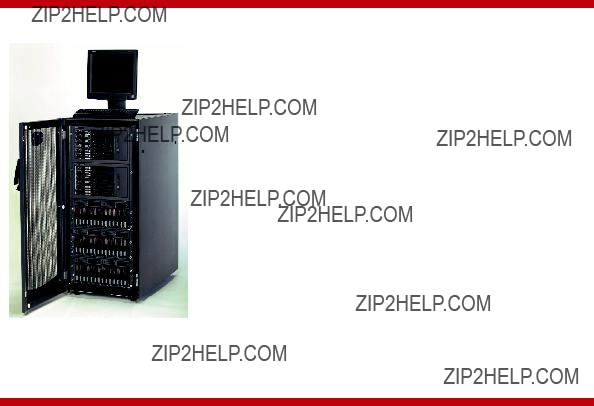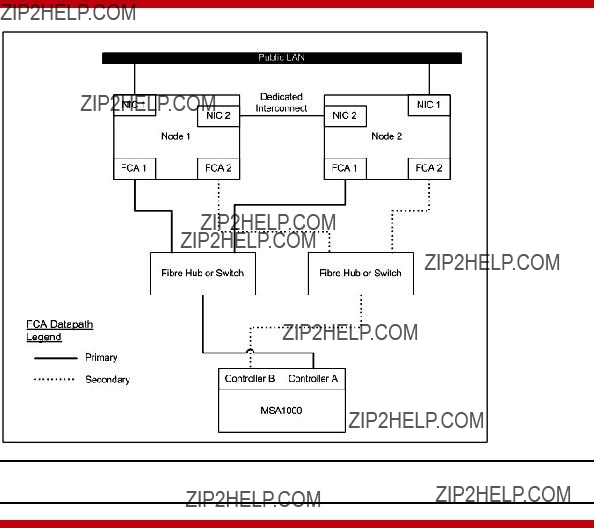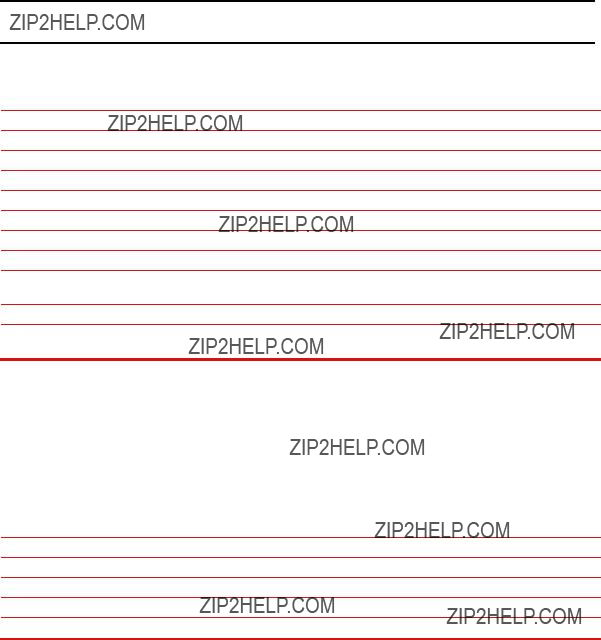
Installation Checklist ??? HP ProLiant Cluster F200 for MSA1000 using Microsoft Windows Server 2003, Enterprise Edition
May 2004

Installation Checklist ??? HP ProLiant Cluster F200 for MSA1000 using Microsoft Windows Server 2003, Enterprise Edition
May 2004

HP ProLiant Cluster F200 for MSA1000
The HP ProLiant Cluster F200 for Modular Smart Array 1000 utilizes HP
Key features of the ProLiant Cluster F200 for MSA1000 include:
???Support for the scalable Modular Smart Array 1000 (MSA1000), designed to reduce the complexity of SAN deployment
???Scalable SANs designed to maximize cluster performance, uptime and storage capacity
???
???Unified suite of HP cluster management tools offer management capabilities to simplify the installation of complex clustered SAN configurations
???Supported in a shared fabric environment
2

Hardware Cabling Scheme
Figure 1. Hardware cabling scheme
Note: This diagram depicts a
Introduction
Microsoft Windows Server 2003, Enterprise Edition is an extension of the Microsoft Windows 2000 operating system environment developed to enhance the customer experience and to improve the overall usability and deployment.
General cluster improvements for Microsoft Windows Server 2003, Enterprise Edition include:
???Larger cluster sizes ??? Enterprise Edition now supports up to 8 nodes.
???Enhanced cluster installation wizard ???
???Installation ??? cluster binaries are automatically copied during the operating system installation.
???
???Active Directory integration ??? tighter integration including a ???virtual??? computer object, Kerberos authentication, and a default location for services to publish service control points. Users can access the virtual server just like any other Windows server.
3

This checklist provides
Software and Hardware Requirements
The following table provides a checklist of the required software versions and, if applicable, any items to execute before beginning the installation. Place a checkmark (3) in the box after completing each step.
??Before installing your HP ProLiant F200 for MSA1000 cluster solution, it is very important to refer to the HP Cluster Configuration Support website for details on components that make up a valid cluster configuration. There is a support matrix for each HP Cluster that details components that represent quality tested and supported HP Cluster configurations.
Using the link below, select the appropriate operating system and storage platform and then refer to the row of deliverables that are relevant to the configuration you require.
The HP Cluster Configuration Support website can be found at
??SmartStart CD.
??Two supported ProLiant servers, supported Fibre Channel Adapters (FCA), two or more supported network adapters, two supported Fibre Channel switches or hubs, and one or more MSA1000(s).
??Review and understand any Read This First (RTF) and Getting Started cards that were shipped with the product.
??Microsoft Windows Server 2003, Enterprise Edition software and documentation.
??If applicable, Microsoft Windows Server 2003, Enterprise Edition service pack.
??HP StorageWorks MSA1000 Support Software CD.
??Array Configuration Utility (ACU), which is located on the HP StorageWorks MSA1000 Support Software CD.
??HP Insight Manager (optional).
??MSA1000 controller firmware.
??EMU firmware.
??FCA firmware and boot bios.
??Fibre Channel switch firmware.
??HP StorageWorks for Windows Workgroup Edition (Included in the ProLiant Cluster F200 for Entry Level SAN Cluster Kit).
??Sufficient software rights to install the operating system and software applications on each node.
??Ensure all hardware is installed and properly cabled as shown in figure 1 - hardware cabling scheme on page 3.
4
Gathering Information
The following table provides a checklist for the required input parameters that will facilitate the operating system and cluster installation. Write the information in the values column next to each item. Place a checkmark (3) in the box after completing each step.
5

??Local machine Administrator password Know the Administrator password (used during OS installation):
??Domain name:
6

Installing Node 1 Operating System
The following table provides a checklist of the operating system installation steps for Node 1. Place a checkmark (3) in the box after completing each step.
??Power on the shared storage. After powering on, wait until the storage system startup complete message appears on the display. It may take up to two minutes for the storage system to completely power up.
??Power on and boot Node 1 with the SmartStart CD in the
??Configure the cluster node using the SmartStart CD. Select Microsoft Windows Server 2003, Enterprise Edition as the operating system and follow the SmartStart
After the OS installation is complete, SmartStart will automatically install the latest HP support software.
??Each cluster node requires at least two network adapters; one to connect to a public network and one to connect to a private network.
For the public network connection: If the network adapter can transmit at multiple speeds, then manually specify a speed and duplex mode. The speed for the network adapter should be hard set (manually set) to be the same on all nodes according to the card manufacturer's specification.
Best Practice: To provide a maximum level of redundancy, use NIC Teaming capabilities for selected HP network products to provide a redundant public network connection. Please note, however, that NIC Teaming is unsupported for the private network connection.
??Configure the TCP/IP settings for the public network connection.
??For the private network connection: To eliminate possible private network cluster communication issues refer to Microsoft Knowledge Base (KB) article
??Configure the TCP/IP settings for the private network connection.
??Join the Windows domain and reboot when prompted.
??After the reboot, log the node into the domain.
??Insert the HP StorageWorks MSA1000 Support Software CD. Click Install Array Configuration Utility (ACU) to install the version of ACU that supports the MSA1000.
??Select the appropriate option to install the FCA drivers for Windows Server 2003, Enterprise Edition.
??Reboot Node 1 when prompted and then log into the domain.
??(Optional) Zone nodes and MSA1000 storage. You may choose this option if adding more than one pair of nodes to the switch. Zoning allows you to further isolate each cluster. For more information about zoning, refer to the ???Zoning User???s Guide??? documentation located at:
??Install the HP StorageWorks Secure Path for Windows Workgroup Edition software.
Insert the HP StorageWorks Secure Path for Windows Workgroup Edition CD to automatically start the Secure Path installation process. Alternatively,
Remove the HP StorageWorks Secure Path for Windows Workgroup Edition CD from the
??Install Secure Path Manager (SPM) on a monitor node. To use Secure Path, install SPM on a machine designated as a monitor node and connected to the same domain as the cluster.
Note: If desired, a Cluster node may also be the Monitor node.
??Shutdown Node 1 when the installation is complete.
7

Installing Node 2+ Operating System
The following table provides a checklist of the operating system installation steps for Node 2+. Place a checkmark (3) in the box after completing each step.
Note: Microsoft Windows Server 2003, Enterprise Edition supports a maximum of 8 cluster nodes. Repeat the following operating system installation steps for each additional node.
??Power on and boot the next node with the SmartStart CD in the
??Configure the cluster node using the SmartStart CD. Select Microsoft Windows Server 2003, Enterprise Edition as the operating system and follow the SmartStart
After the OS installation is complete, SmartStart will automatically install the latest HP support software.
??Each cluster node requires at least two network adapters; one to connect to a public network and one to connect to a private network.
For the public network connection: If the network adapter can transmit at multiple speeds, then manually specify a speed and duplex mode. The speed for the network adapter should be hard set (manually set) to be the same on all nodes according to the card manufacturer's specification.
Best Practice: To provide a maximum level of redundancy, use NIC Teaming capabilities for selected HP network products to provide a redundant public network connection. Please note, however, that NIC Teaming is unsupported for the private network connection.
??Configure the TCP/IP settings for the public network connection.
??For the private network connection: To eliminate possible private network cluster communication issues refer to Microsoft Knowledge Base (KB) article
??Configure the TCP/IP settings for the private network connection.
??Join the Windows domain and reboot when prompted.
??After the reboot, log the node into the domain.
??Insert the HP StorageWorks MSA1000 Support Software CD. Click Install Array Configuration Utility (ACU) to install the version of ACU that supports the MSA1000.
??Select the appropriate option to install the FCA drivers for Windows Server 2003, Enterprise Edition.
??Reboot Node 2 when prompted and then log into the domain.
??Install the HP StorageWorks Secure Path for Windows Workgroup Edition software.
Insert the HP StorageWorks Secure Path for Windows Workgroup Edition CD to automatically start the Secure Path installation process. Alternatively,
Remove the HP StorageWorks Secure Path for Windows Workgroup Edition CD from the
??Shutdown the node when the installation is complete.
??Microsoft Windows Server 2003, Enterprise Edition supports up to 8 nodes in a cluster. Repeat the Installing Node 2+ Operating System instructions on any additional nodes that will join the cluster.
8

Configuring the Shared Storage
The following table provides a checklist of the steps necessary to configure the MSA1000 storage. Place a checkmark (3) in the box after completing each step.
??Power on Node 1 and log into the domain.
??From the desktop of Node 1, select Start ?? Programs ?? Compaq/HP System Tools ?? hp Array Configuration Utility ?? hp Array Configuration Utility.
Note: The Internet Connection Wizard
??Select the MSA1000 controller to configure the shared storage hard drives. Refer to the user guide for the MSA1000 storage system for additional details.
If sharing an MSA1000 between multiple clusters, Selective Storage Presentation (SSP) is required for configuration. Refer to the ACU documentation for information on using SSP.
??Configure the shared storage drives.
IMPORTANT: Create a logical drive using ACU on one of the MSA1000 arrays with at least 510MB of space. Microsoft recommends at least 500MB for the cluster Quorum drive. The extra space for the logical drive size specified in ACU is to account for internal disk size calculations used by ACU. Specifying 510MB will ensure that this size of this disk will be at least 500MB of formatted drive space for use as the Quorum drive. Refer to Microsoft Knowledge Base Article ??? 280345 or the help documentation on the cluster node for more information on cluster disk sizes.
??After the shared storage drives are configured, select Start ?? Programs ?? Administrative Tools ?? Computer Management. Then select Disk Management to create volumes out of the logical drives.
Important: DO NOT upgrade the logical drives from Basic to Dynamic. Microsoft Cluster Services does not support dynamic disks.
??Be sure to assign drive letters and format the volumes as NTFS.
??Close Disk Management for Microsoft Windows Server 2003, Enterprise Edition.
Creating the Cluster
The following table provides a checklist for creating the cluster from Node 1. Place a checkmark (3) in the box after completing each step.
??From Node1, select Start ?? Programs ?? Administrative Tools ?? Cluster Administrator.
??Select Create New Cluster from the Action
??Click Next on the welcome screen.
??Select the domain to create the cluster in and enter a name for the cluster. Click Next.
??Enter the name of the first server to be in the cluster. Click Next.
??When the cluster wizard finishes analyzing the configuration, click Next.
??Enter the IP address for the cluster. Click Next.
??Enter the username and password for the cluster. Click Next.
??Verify the proposed cluster configuration. Click Next.
??When the wizard has finished creating the cluster, click Next, and then click Finish.
??Select Start ??Control Panel ?? HP Management Agents. In the list of Inactive Agents, select Clustering Information and click Add to move this agent to the list of active agents and click OK.
??Restart the agents when prompted.
9

Joining Node 2+ to the Cluster
The following table provides a checklist for the process of joining Node 2+ to the cluster. Place a checkmark (3) in the box after completing each step.
Note: Microsoft Windows Server 2003, Enterprise Edition supports a maximum of 8 cluster nodes. Repeat the following steps for each additional node.
??Power on Node 2+ and log into the domain.
??From Node 2+, select Start?? Programs?? Administrative Tools?? Cluster Administrator.
??Select Add nodes to cluster from the Action
??Click Next on the welcome screen.
??Enter the name of the server that you want to join the cluster, click Add and then click Next.
??When the cluster wizard finishes analyzing the configuration, click Next.
??Enter the password for the cluster. Click Next.
??Verify the proposed cluster configuration. Click Next.
??When the wizard has finished adding the node to the cluster, click Next, and then click Finish.
??Select Start ??Control Panel ?? HP Management Agents. In the list of Inactive Agents, select Clustering Information and click Add to move this agent to the list of active agents, and then click OK.
??Restart the agents when prompted.
??Microsoft Windows Server 2003, Enterprise Edition supports up to 8 nodes in a cluster. Repeat the Joining Node 2+ to the Cluster installation instructions for each additional node.
Validating the Cluster Configuration
To validate the cluster installation, perform the following steps from any cluster node. Place a checkmark (3) in the box after completing each step.
??From the desktop of any node, select Start ?? Programs ?? Administrative Tools ?? Cluster Administrator, and connect to the cluster.
??Right click on one of the cluster groups and select Move Group.
??Verify the group fails over and all resources come online.
??Right click on the same cluster group and select Move Group.
??Verify that the group fails over and all resources come online.
??Repeat the validating the cluster configuration steps, if desired, for each group.
The installation is now complete.
10

For more Information
To learn more about HP High Availability and ProLiant Clusters visit the following Web site: http://www.hp.com/servers/proliant/highavailability.
Feedback
Help us improve our technical communication. Let us know what you think about the technical information in this document. Your feedback is valuable and helps us structure future communications. Please send your comments to hawebserver@hp.com.
365196- 001
?? 2004
Microsoft and Windows are U.S. registered trademarks of Microsoft
Corporation.
Printed in the USA
11